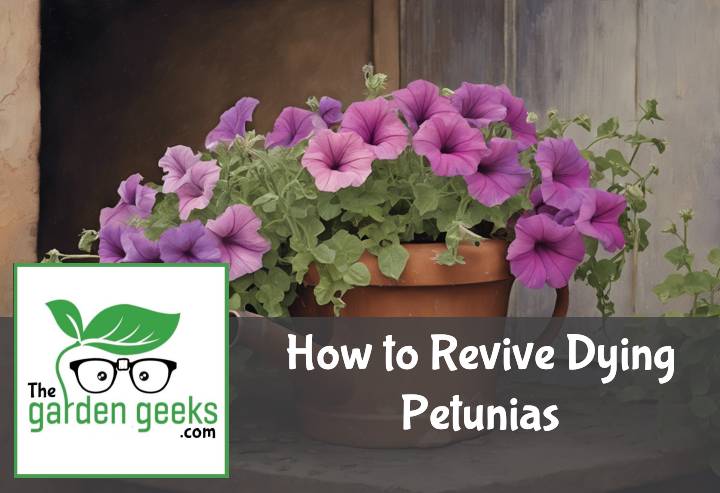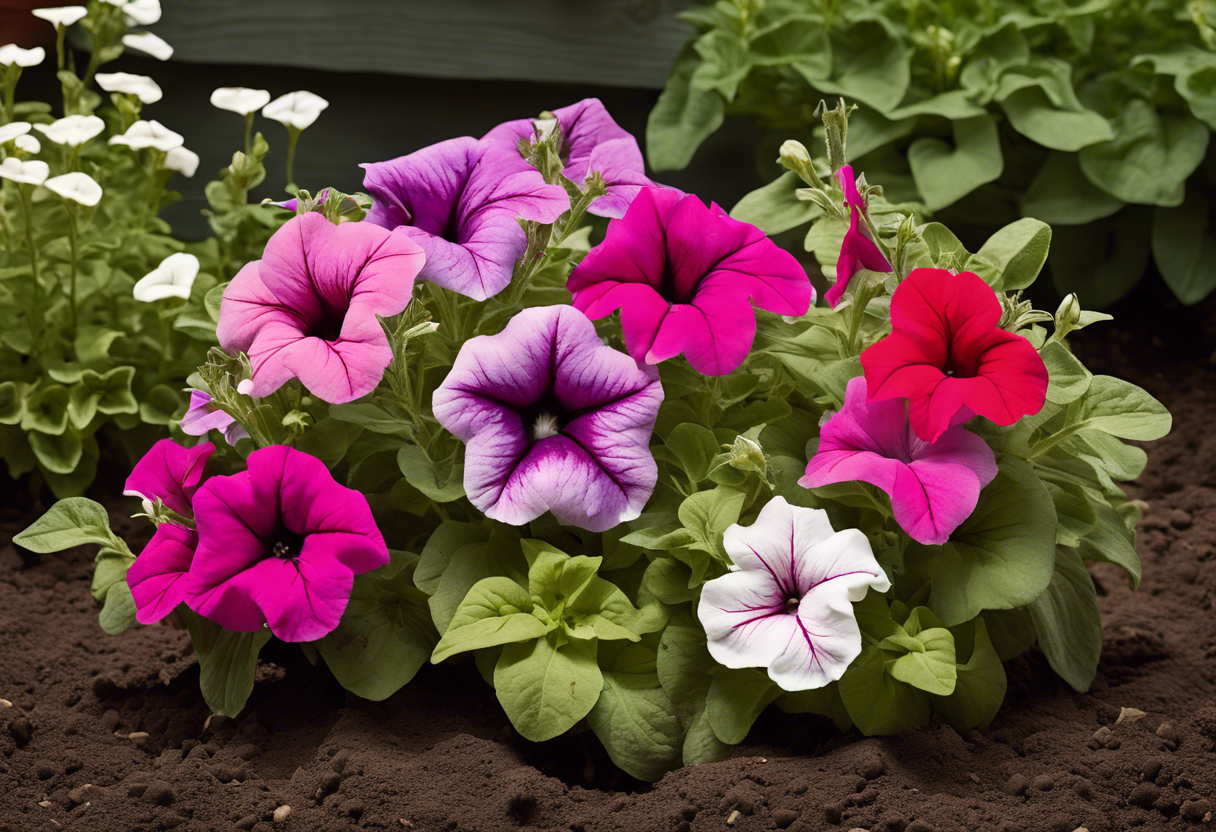Hey there, green thumb! I bet you’re here because your beloved petunias are looking a bit under the weather. Well, don’t fret! We’ve all been there. Even the most seasoned gardeners have had their fair share of plant casualties. But the good news is, you can learn How to Revive Dying Petunias.
In this blog post, we’ll walk through some simple yet effective ways to bring your wilting petunias back to life. So stick around, and let’s turn that brown thumb green again! Remember, gardening is not about perfection; it’s about patience and persistence. Keep reading about How to Revive Dying Petunias.
Key Takeaways
- Identify the problem with your petunias: overwatering, underwatering, or disease.
- Overwatered petunias have yellow leaves and wilted flowers; let them dry out before watering again.
- Underwatered petunias have dry, brittle leaves; water them thoroughly and regularly.
- Diseased petunias may have spots or discoloration; remove affected parts and treat with a fungicide.
- Ensure they get at least 6 hours of sunlight daily and use a balanced fertilizer for optimal growth.
Understanding Petunia Health
When it comes to petunia care, it’s crucial to recognize the signs of a healthy plant versus a dying one. Understanding petunia health issues can be the difference between vibrant, blooming petunias and wilting, dying petunias.
Identifying Signs of a Dying Petunia
So, how do you know if your petunia is on its way out? Well, there are several visual cues to look out for. One telltale sign is wilting petunias. If your plant looks droopy and sad, it might be in trouble.
Another symptom is yellowing leaves. This could indicate that your petunia isn’t getting the nutrients it needs or that it’s overwatered. Finally, keep an eye on the growth patterns of your plant.
If you notice stunted growth in petunias, this could be another sign that your plant isn’t doing so well. Remember, knowing these signs is essential in learning how to revive dying petunias.
Common Causes of Petunia Decline
Now that we’ve identified the signs let’s talk about what might cause these issues. One common culprit is disease; yes, even plants get sick! So watch out for any signs of petunia diseases.
Another common issue is watering – too much or too little can both lead to problems. Overwatering can drown the roots while under watering can leave them parched and unable to absorb nutrients properly.
Finally, poor soil conditions can also lead to declining health in petunias. If the soil doesn’t drain well or lacks necessary nutrients, your petunias may struggle.
Remember folks, understanding these causes is key in figuring out how to bring those dying beauties back to life!
Assessing Your Petunias’ Condition
Before you can start figuring out how to revive dying petunias, it’s crucial to do a thorough petunia health check. This involves examining the soil and root health, as well as checking for any pesky petunia pests or petunia diseases.
Examining the Soil and Root Health
When it comes to your petunias, the state of their roots and soil can tell you a lot. Start by conducting a simple petunia soil examination. If the soil is dry and crumbly, that’s a red flag. Petunias prefer moist, well-drained soil.
Next up, take a peek at those roots. Healthy roots are generally white or light brown and firm to touch. If you notice dark, mushy roots, that’s not good news – it’s one of the classic signs of unhealthy roots.
Checking for Pests and Diseases
Now let’s talk about bugs and blights. Identifying common pests and diseases early on can save your petunias from an untimely demise. Look out for aphids, slugs, or whiteflies – these are some of the most common culprits when it comes to petunia pests identification.
As for diseases, keep an eye out for signs like yellow leaves or black spots – these could indicate one of the many common diseases in petunias. Remember: prevention is better than cure! Regularly inspecting your plants can go a long way in preventing pest infestation in petunias.
Reviving Your Dying Petunias: Immediate Actions
When your petunias start to wilt, don’t panic. It’s time for some immediate actions to revive dying petunias and bring them back to their blooming best. Let’s dive into the rescue mission for your unhealthy petunias.
Adjusting Watering Practices
First things first, let’s talk about H2O. You see, proper watering for petunias is crucial, but it can be a bit tricky. Overwatering or underwatering both can lead to wilting. So how do you find the sweet spot?
Well, it’s all about balance. Petunias don’t like having wet feet all the time, so avoid overwatering which can cause root rot. On the other hand, they also don’t appreciate being parched – that’s where you see those underwatering symptoms in petunias.
The key here is to maintain an optimal watering schedule for petunias based on their specific water requirements. Generally speaking, a good soak once or twice a week should do the trick.
Pruning and Deadheading
Next up on our emergency care list for petunias is pruning and deadheading. These are not just fancy gardening terms but essential steps in reviving your wilting beauties.
Pruning involves cutting back overgrown or damaged parts of your plant – think of it as giving your petunia a fresh haircut! This encourages new growth and helps save wilting petunias from further damage.
Now onto deadheading – this is simply removing faded or dead flowers from the plant. Deadheading not only keeps your plant looking neat but also directs energy towards producing more blooms instead of seeds.
So there you have it folks! With these immediate actions for plant health, you’re well on your way on how to revive dying petunias. Remember, it’s all about the right balance of water and a little bit of plant pampering with pruning and deadheading.
Long-Term Care Strategies for Healthy Petunias
The secret to maintaining healthy petunias isn’t just about knowing how to revive dying petunias, but also understanding the long-term care strategies. It’s all about the right soil, fertilizer, and sunlight exposure.
Choosing the Right Soil and Fertilizer
Now, let’s talk dirt. Not gossip, actual dirt! The best soil for petunias is well-drained and rich in organic matter. Your petunias will be saying “Yum!” in no time.
But wait, there’s more! Adding an ideal fertilizer for petunias can make a world of difference. A nutrient-rich fertilizer can give your flowers that extra oomph they need to thrive.
Remember folks, improving petunia health with soil and fertilizer isn’t rocket science. It’s just good old-fashioned plant parenting!
Ensuring Proper Sunlight Exposure
Sunlight: it’s not just for beach days! Your petunias need their daily dose of Vitamin D too. The sunlight requirements for petunias are pretty straightforward – they love basking in full sun.
But don’t go overboard! Too much of a good thing can be harmful. Striking a balance with the optimal sun exposure for petunias is key to keeping them happy and healthy.
So there you have it folks! Remember, the effects of sunlight on your petunia health are huge. So let’s keep those rays coming (but not too many!).
Preventive Measures to Keep Petunias Thriving
In the world of petunia care, prevention is indeed better than cure. Keeping your petunias thriving and healthy isn’t rocket science, it’s all about regular monitoring and effective pest control methods.
Regular Monitoring and Maintenance
Regular monitoring is like a routine check-up for your petunias. It helps you keep an eye on their health status. You can spot any signs of wilting or disease early on, giving you a fighting chance to revive dying petunias before it’s too late.
Maintenance is another key aspect of petunia care tips that cannot be overstated. Regular watering, proper fertilization, and timely pruning are all part of the package. These simple practices help maintain healthy petunias and prevent diseases from gaining a foothold in the first place.
Pest Control Methods
Now let’s talk about those pesky pests that love to feast on your precious petunias. Effective pest control methods are crucial in protecting your flowers from these unwanted guests.
Organic pest control for flowers is a safe and eco-friendly option. Neem oil or insecticidal soaps can do wonders in keeping pests at bay without harming your plants or the environment.
Another method involves introducing beneficial insects into your garden. These little heroes, like ladybugs or lacewings, naturally prey on harmful pests providing a natural line of defense for your plants.
Remember folks, when it comes to thriving petunias, an ounce of prevention truly is worth a pound of cure!
To Wrap Up
So, we’ve journeyed through the garden of knowledge on How to Revive Dying Petunias. It’s been a bit like playing plant doctor, hasn’t it? Remember, just like making a perfect pancake flip, reviving petunias takes practice and patience.
In the end, your petunias are counting on you. So go forth and breathe new life into those wilted beauties!





